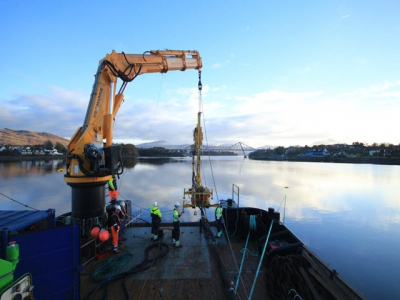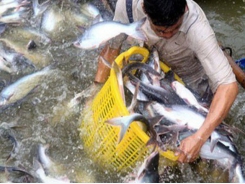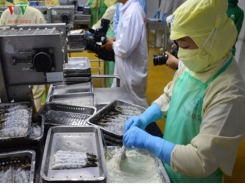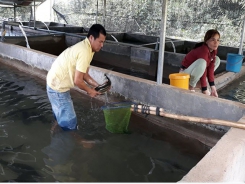Less is mooring: a fresh approach to fish farm technology

An innovative new anchoring technology which could allow Scotland's aquaculture sector to move into high energy marine locations is being developed by a consortium of engineering experts.
ROVs are likely to be crucial for anchoring fish farms in high energy locations. Photo © SAIC
Sustainable Marine Energy, the tidal energy technology specialist; the University of Dundee; marine equipment supplier, Gael Force Group; and the Scottish Aquaculture Innovation Centre (SAIC) are exploring the development of a ‘groutless’ anchoring approach, derived from techniques currently used in highly energetic marine energy sites.
The technology could significantly support the aquaculture industry in finding ways to anchor farms in new locations. While concrete or steel anchors are suitable for existing sites, the technology will enhance the options available for high-energy locations, as well as those further from the shore, with solid rock on the seabed.
Focused on reducing the cost, weight, and environmental impact of anchoring, the new approach will use much lighter anchors which form a mechanical ground lock without the need for resin or grout. The reduction in weight allows operators to use more modestly-sized, readily available vessels for deployment.
Using a remotely-operated drilling rig positioned from a workboat also enables operators to be more precise with installation in deep-water, high-energy sites. The use of low-noise rotational drilling would minimise disturbance to the marine ecosystem and damage to the seabed, while the anchors would be fully removable and potentially re-usable.
Andy Hunt, chief engineer for anchoring and connectivity at Sustainable Marine Energy, said: “For some time we have seen applications in other sectors that would benefit from adaptations to our rock anchoring technology. For us, this project brings together a very strong Scottish team of project partners with the appropriate skill set and experience to develop the right rock anchoring solution for the aquaculture market. Together, we can quickly begin to unlock the sector’s latent potential, by opening up areas hitherto unsuitable for aquaculture farms.”
Michael Brown, reader at the University of Dundee’s Geotechnical Engineering Research Group, commented: “This type of anchor technology allows deployment in more energetic environments and in deeper water, with increased confidence with respect to performance on solid rock. The challenge from an engineering perspective is to develop an anchor that is efficient, easy to design and works in variety of rock types and rock mass conditions. While it is easy to design a heavy and expensive rock anchor that works well in all scenarios, we need to refine the anchoring system specifically for aquaculture application.
“To achieve this, we will use both scale-model testing and calibrated numerical simulation of the rock anchor systems under realistic operational conditions. This is a specialist area of expertise at the University of Dundee, currently being used to develop foundation and anchoring systems for tidal stream generators and future floating wind farms.”
Adoption of the technology would allow fish and shellfish farms to look at areas which are currently unsuitable for use. Locating operations in deeper, higher energy waters could potentially help to reduce gill health issues among fish, the spreading of sea lice, and disease risk. It could also lead to an increase in the industry’s capacity, by allowing the development of larger farms.
Polly Douglas, aquaculture innovation manager at SAIC, added: “This technology could prove a real breakthrough for aquaculture in Scotland, enhancing sustainability in the industry and unlocking some of its latent potential. If successful, the new anchoring technique would support the industry in meeting many of the Scottish Government’s long-term ambitions for the sector, providing a sustainable foundation on which we can double the economic contribution and number of people employed in aquaculture between 2016 and 2030. It builds on many of our previous projects around the prevention of sea lice, gill health, and environmental impact by adopting approaches taken in other sectors and applying them to aquaculture.”
Có thể bạn quan tâm
Phần mềm

Phối trộn thức ăn chăn nuôi

Pha dung dịch thủy canh

Định mức cho tôm ăn

Phối trộn phân bón NPK

Xác định tỷ lệ tôm sống

Chuyển đổi đơn vị phân bón

Xác định công suất sục khí

Chuyển đổi đơn vị tôm

Tính diện tích nhà kính

Tính thể tích ao hồ




 Tra fish prices hit 10-year low
Tra fish prices hit 10-year low  Farmers earn higher incomes from coldwater fish
Farmers earn higher incomes from coldwater fish